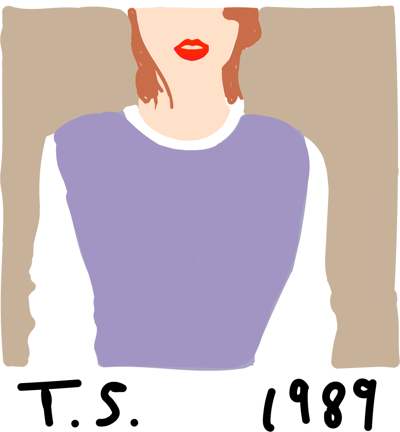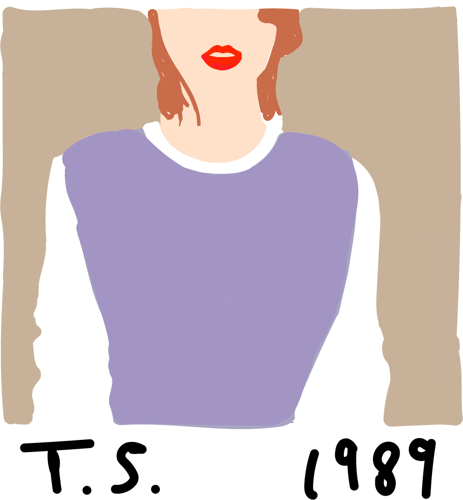On Oct. 27 at midnight, Swifties around the globe gathered around their computers and put in their headphones to listen to one of the most awaited albums of this fall, “1989 (Taylor’s Version).”
Re-recording an entire discography is a feat in and of itself, but undertaking an album as beloved and popular as “1989” is Swift's most carefully balanced act yet. “1989” rehashes a 24-year-old-self’s heartbreak through a 33-year-old’s wisdom, and it’s as applicable today as it was nine years ago.
Just like Swift herself, the sound of “1989 (Taylor’s Version)” matured across the board. This is most notable in two of her songs, “Style” and “Wildest Dreams,” as both carry a dreamy, romantic quality the rest of the album lacks. The production in these songs is a nod to the naiveté of immature love — themes prevalent throughout the previous version and Swift’s young life.
Swift draws out the trademark guitar riff of “Style” and the slow heartbeat of “Wildest Dreams’” to build up to a bass-boosted chorus. This ebb and flow facilitates an emotional buildup that reflects all the “what-ifs” of Swift’s early relationships. Perhaps it is this added nuance that gives Swift room to play; if Swift has learned anything from the albums proceeding “1989,” it's when to play it up and when to let silence speak for itself.
Swift also knows when not to mess with perfection.
There were many songs like “All You Had To Do Was Stay” and “How You Get The Girl” where there’s no difference between the original and re-recorded version. Swift’s attention to detail in these songs shows her loyalty to a fanbase which has deep emotional ties to her original work.
There was one song which majorly flopped: “Shake It Off.”
This song sounds sterilized. Yes, the notes, lyrics — even Swift’s little laugh in between verses are all the same — but heavy autotune and a stripped chorus make it hard to remember why we were so enamored with this song in the first place. For a song that was such a tour de force when it was originally released, reducing it to a robotic tweeny-bop is a low blow.
Where “1989 (Taylor’s Version)” really shines is with the vault tracks. In Swift's opening statement on her limited-edition records, she touches on how “1989” was written during a period of her life when she wanted to experiment personally and musically. She had a lot of changes to be excited about — think “Welcome To New York” — and also wanted to cast off her old image, seen in the satire in “Blank Space” and "Bad Blood.” But underneath all the excitement, the vault tracks reveal very real pain.
Swift starts the vault tracks with “Slut!,” a more mature, emotional version of “Shake it Off.” The media ruthlessly slut-shamed Swift in the time surrounding 1989’s release; rather than taking it personally, “Slut!” details the painful position of settling with your fate and accepting what you have.
The rest of the vault tracks reflect, sometimes bitterly, on a push-and-pull, ambiguous love. The term “situationship” may not have been fully realized in 2014, but anyone who’s dated in 2023 recognizes the signs, and Swift captures the acute struggle of them perfectly.
The abrupt end of “Now That We Don’t Talk,” for example, perfectly represents the sense of emptiness you can feel when a two-month talking stage abruptly falls through. The emotions are still there, but the closure never will be.
Swift best describes this heartbreak in “Say Don’t Go” when she rages: “Why’d you have to lead me on/Why’d you have to twist the knife/Walk away and leave me bleeding” in one line, then proclaims, “I would stay forever if you/Say/Don’t/Go.” Despite all her longing, Swift acknowledges there’s nothing she could do to make her love — a certain former One Direction member, perhaps — reciprocate, and it feels like a physical wound.
Ending with “Is It Over Now?” — not counting Kendrick Lamar’s remix of “Bad Blood” as a real ending track — brilliantly finishes “1989 (Taylor’s Version)” on a musical cliffhanger. Just as the relationship in “Is It Over Now?” finds Swift with wide-open possibilities, so too did the end of “1989.” Swift was standing on the edge of a precipice between country and pop, fame and stardom, the Taylor Swift of old and the superpower we know now, and she knows it.





(0) comments
Welcome to the discussion.
Log In
Keep it Clean. Please avoid obscene, vulgar, lewd, racist or sexually-oriented language.
PLEASE TURN OFF YOUR CAPS LOCK.
Don't Threaten. Threats of harming another person will not be tolerated.
Be Truthful. Don't knowingly lie about anyone or anything.
Be Nice. No racism, sexism or any sort of -ism that is degrading to another person.
Be Proactive. Use the 'Report' link on each comment to let us know of abusive posts.
Share with Us. We'd love to hear eyewitness accounts, the history behind an article.